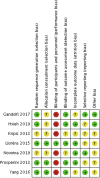Effect of home-based virtual reality training and telerehabilitation on balance in individuals with Parkinson disease, multiple sclerosis, and stroke: a systematic review and meta-analysis
- PMID: 35175439
- PMCID: PMC9023738
- DOI: 10.1007/s10072-021-05855-2
Effect of home-based virtual reality training and telerehabilitation on balance in individuals with Parkinson disease, multiple sclerosis, and stroke: a systematic review and meta-analysis
Abstract
Objective: In the last decade, there is a growing interest in the use of virtual reality for rehabilitation in clinical and home settings. The aim of this systematic review is to do a summary of the current evidence on the effect of home-based virtual reality training and telerehabilitation on postural balance in individuals with central neurological disorders.
Methods: Literature was searched in PubMed, Web of Science, PEDro, ScienceDirect, and MEDLINE. Randomized controlled trials (RCTs) evaluating the effect of home-based virtual reality (VR) training and telerehabilitation (TR) on postural balance in patients with Parkinson's disease, Multiple sclerosis or stroke. Studies were imported to EndNote and Excel to perform two screening phases by four reviewers. Risk of bias was assessed using PEDro scale and Cochrane assessment tool for risk of bias. Synthesis of the data on comparative outcomes was performed using RevMan software.
Results: Seven RCTs were included, with all three pathologies represented. VR and TR consisted of a training device (e.g., Nintendo Wii or Xbox 360) and a monitoring device (e.g., Skype or Microsoft Kinect). Five studies used the Berg Balance Scale (BBS) for measuring postural balance. Across studies, there was an improvement in BBS scores over time in both experimental and control groups, and the effect remained at follow-up for both groups. However, there was no significant difference between groups post-intervention (MD = 0.74, p = 0.45).
Conclusion: Home-based VR and TR can be used as prolongation to conventional therapy.
Keywords: Balance; Multiple sclerosis; Parkinson’s disease; Stroke; Telerehabilitation; Virtual reality.
© 2022. Fondazione Società Italiana di Neurologia.
Conflict of interest statement
The authors declare no competing interests.
Figures





References
-
- Feigin VL, Nichols E, Alam T, Bannick MS, Beghi E, Blake N, et al. Global, regional, and national burden of neurological disorders, 1990–2016: a systematic analysis for the Global Burden of Disease Study 2016. Lancet Neurol. 2019;18(5):459–480. doi: 10.1016/S1474-4422(18)30499-X. - DOI - PMC - PubMed
-
- Feigin VL, Abajobir AA, Abate KH, Abd-Allah F, Abdulle AM, Abera SF, Aichour MTE. Global, regional, and national burden of neurological disorders during 1990–2015: a systematic analysis for the Global Burden of Disease Study 2015. Lancet Neurol. 2017;16(11):877–897. doi: 10.1016/S1474-4422(17)30299-5. - DOI - PMC - PubMed
-
- World Health Organization, editor. Neurological disorders: public health challenges. Geneva: World Health Organization; 2006. 218 p. Available from: https://www.who.int/mental_health/neurology/neurological_disorders_repor.... Accessed Sep 2021
-
- Nederlandse Vereniging voor Neurologie. Multiple sclerose. Federatie Medisch Specialisten. Published 2012. https://richtlijnendatabase.nl/richtlijn/multipele_sclerose/multipele_sc...
-
- Van Nimwegen M, Nijkrake M, Munneke M, de Groot D, Heijblom KG, Meerhoff GA. KNGF-richtlijn ziekte van Parkinson. 19:26. Available from: https://www.parkinsonnet.nl/app/uploads/2019/11/KNGF-richtlijn-Ziekte-va...
Publication types
MeSH terms
LinkOut - more resources
Full Text Sources
Other Literature Sources
Medical

